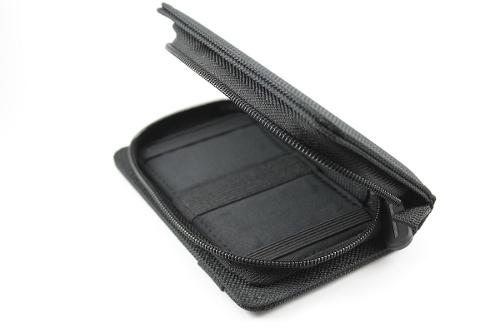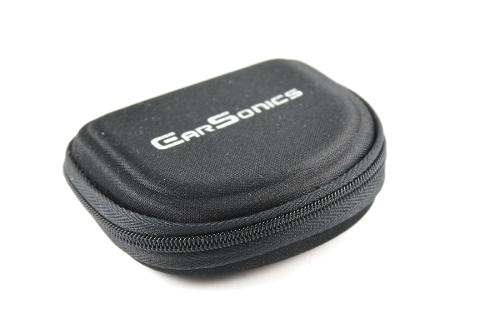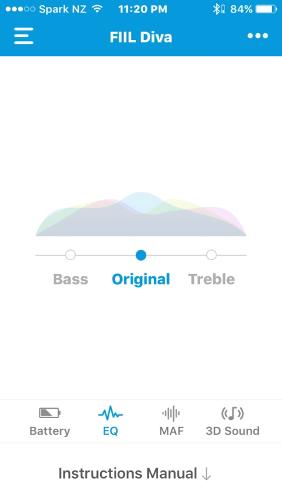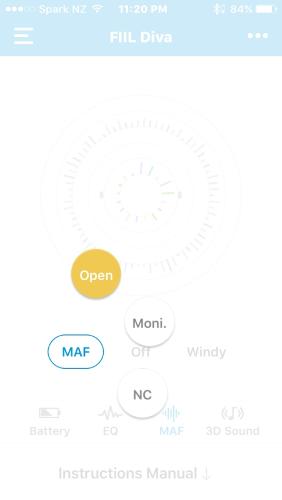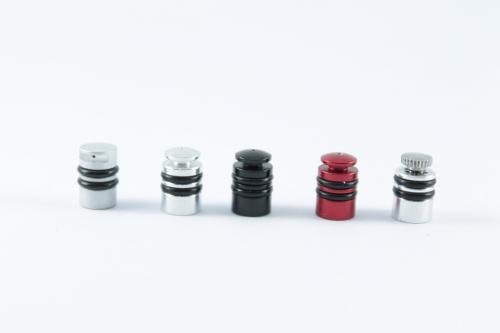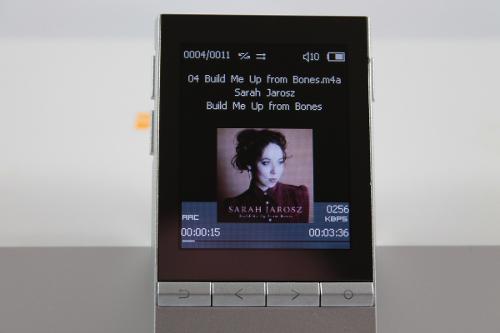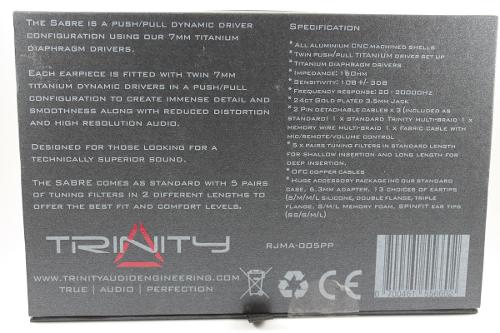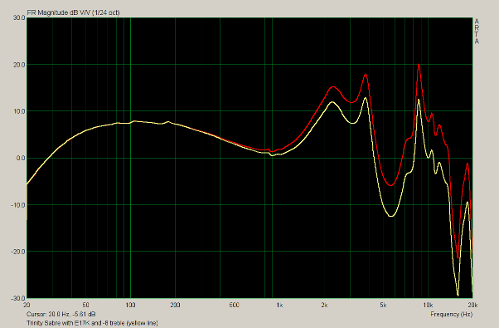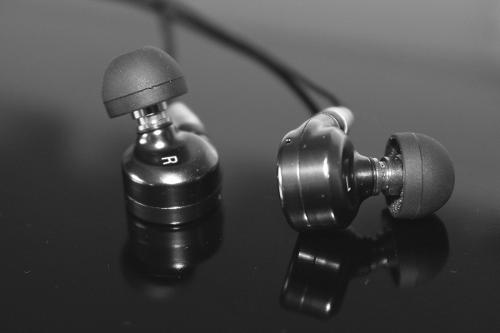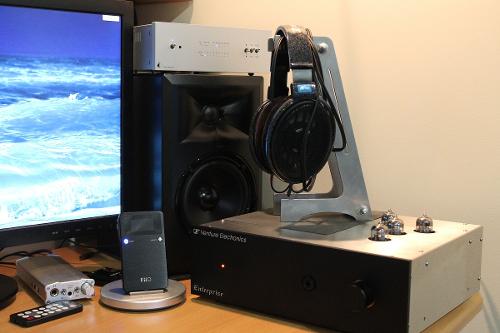[size=24.57px]INTRODUCTION[/size]
I was first introduced to RHA (or Reid Heath Acoustics) during a review tour for the RHA T10i, and later the RHA T20. I was very impressed with the build and fit on both earphones, but less impressed with the T10i signature (too bassy IMO), and pleasantly surprised with their T20 – which I still regard as a very good earphone in its price range. So when their new CL range was announced late in 2016, I was very keen to review, and especially so when there had been a little bit of controversy around early impressions of their earphones. Call me nosy – but when this happens, I just really need to get a listen. I also wanted to measure the CL range, as its easier to really discover truth when you can compare what you hear with what you are able to measure. So join me in a small voyage of discovery as we put the CL750 through its paces.ABOUT RHA
Reid Heath Acoustics (RHA) is a Scottish based headphone company. Their core values (from their on-line presence) are described as follows:
“We stand for true-to-life audio reproduction and lasting quality. With these values at our core, we work to deliver the most accurate, comfortable and unobtrusive listening experience possible. Every RHA product combines high quality materials, precision engineering and our fundamental commitment to design.”
Their current product catalogues ranges from the budget oriented MA350 (~ USD 30) to the current flagship CL1 (~ USD 450). The CL750 sits at $140 – which is in a nicely mid-tier pricing bracket.
In the last couple of weeks I have spent as much time as possible listening to the CL750, CL1 and also their L1 DAC/amp. Sadly I don't have a chance to directly compare to the original T10i or T20 (they were part of a tour), but toward the end of the review I have compared the CL750 to some other IEMs in similar price brackets.
In the time I've spent with the CL750, I’d estimate that I’ve logged around 20 hours actual listening time.
RHA on Facebook
RHA Website
DISCLAIMER
I was provided the RHA CL750 (as part of a tour) from RHA. I am in no way affiliated with RHA - and this review is my subjective opinion of the CL750. The tour unit was returned at completion of the review. I'd like to especially thank Iain and Niketa for their brilliant communication and allowing me to be part of this.
PREAMBLE - 'ABOUT ME'. (or a base-line for interpreting my thoughts and bias)
I'm a 49 year old music lover. I don't say audiophile – I just love my music. Over the last couple of years, I have slowly changed from cheaper listening set-ups to my current set-up. I vary my listening from portables (including the FiiO X5ii, X3ii, X7, LP5, L3, and iPhone SE) to my desk-top's set-up (PC > USB > iFi iDSD). I also use a portable set-up at work – usually either X3ii/X7/L3 > HP, or PC > E17K > HP. My main full sized headphones at the time of writing are the Sennheiser HD800S, Beyerdynamic T1, Sennheiser HD600 & HD630VB, and AKG K553. Most of my portable listening is done with IEMs, and lately it has mainly been with the Jays q-Jays, Alclair Curve2 and Adel U6. A full list of the gear I have owned (past and present is listed in my Head-Fi profile).
I have very eclectic music tastes listening to a variety from classical/opera and jazz, to grunge and general rock. I listen to a lot of blues, jazz, folk music, classic rock, indie and alternative rock. I am particularly fond of female vocals. I generally tend toward cans that are relatively neutral/balanced, but I do have a fondness for clarity, and suspect I might have slight ‘treble-head’ preferences. I am not treble sensitive (at all), and in the past have really enjoyed headphones like the K701, SR325i, and of course the T1 and DT880. I have a specific sensitivity to the 2-3 kHz frequency area (most humans do) but my sensitivity is particularly strong, and I tend to like a relatively flat mid-range with slight elevation in the upper-mids around this area.
I have extensively tested myself (ABX) and I find aac256 or higher to be completely transparent. I do use exclusively red-book 16/44.1 if space is not an issue. All of my music is legally purchased (mostly CD – the rest FLAC purchased on-line). I tend to be sceptical about audiophile ‘claims’, don’t generally believe in burn-in, have never heard a difference with different cables, and would rather test myself blind on perceived differences. I am not a ‘golden eared listener’. I suffer from mild tinnitus, and at 49, my hearing is less than perfect (it only extends to around 14 kHz nowadays). My usual listening level is around 65-75 dB.
I have very eclectic music tastes listening to a variety from classical/opera and jazz, to grunge and general rock. I listen to a lot of blues, jazz, folk music, classic rock, indie and alternative rock. I am particularly fond of female vocals. I generally tend toward cans that are relatively neutral/balanced, but I do have a fondness for clarity, and suspect I might have slight ‘treble-head’ preferences. I am not treble sensitive (at all), and in the past have really enjoyed headphones like the K701, SR325i, and of course the T1 and DT880. I have a specific sensitivity to the 2-3 kHz frequency area (most humans do) but my sensitivity is particularly strong, and I tend to like a relatively flat mid-range with slight elevation in the upper-mids around this area.
I have extensively tested myself (ABX) and I find aac256 or higher to be completely transparent. I do use exclusively red-book 16/44.1 if space is not an issue. All of my music is legally purchased (mostly CD – the rest FLAC purchased on-line). I tend to be sceptical about audiophile ‘claims’, don’t generally believe in burn-in, have never heard a difference with different cables, and would rather test myself blind on perceived differences. I am not a ‘golden eared listener’. I suffer from mild tinnitus, and at 49, my hearing is less than perfect (it only extends to around 14 kHz nowadays). My usual listening level is around 65-75 dB.
This is a purely subjective review - my gear, my ears, and my experience. Please take it all with a grain of salt - especially if it does not match your own experience.
THE REVIEW
PACKAGING AND ACCESSORIESThe RHA CL750 arrived in a reasonably large, but attractive black retail box measuring 143 x 200 x 74mm. There is a lot of information on the packaging (which is IMO very well laid out) – including:
- Front face = picture of the CL750, Sony Hi-Res logo, and instruction that an amplifier would be required (nice touch)
- Rear = information on design, materials and frequency
- Sides = information on warranty (3 year!) and contents
- Bottom = CL750 specifications
Opening the bottom flap allows you to slide out the internal tray which reveals the CL750 nestled in its foam cut-out. Below this are compartments for carry case, tips, tray, manual, and for the cable to sit.
The carry case is a largish padded zippered case measuring approximately 130mm x 85mm x 25-30mm (at its deepest point & depending what you include when packed) – so while it’s not pants pocket friendly, it does pocket very well inside a light jacket. It is well padded, with generous inner pockets and a mesh/canvas-like outer covering. The case is large enough to hold the tips in their steel display tray.
The tip selection is generous, and along with the storage tray includes 2 pairs of dual flange silicone, 6 pairs of single flange silicone, and 3 pairs of Comply Tsx-200 foam tips. The mounting tray is stainless steel and from past experience, works really well as a storage medium. There is also a small plastic shirt clip. As I was first recipient on tour, I've shown pictures of both how the tips come, and how they are mounted on the tray. Fellow members in the tour – feel free to use these photos if you wish.
The manual is multilingual, very informative and includes a frequency graph (which incidentally corresponds very closely with my own – nice to know my rig is recording things nicely).
TECHNICAL SPECIFICATIONS
(From RHA)
| | RHA CL750 |
| Cost | USD 139.95 (RHA website) |
| Type | Single dynamic inner ear monitor |
| Driver Type | Ultra wide band ceramic (CL) transducer |
| Frequency Range | 16Hz – 45 kHz |
| Impedance | 150 ohms |
| Sensitivity | 89 dB |
| Jack | 3.5mm gold plated - straight |
| Cable | 1.35m fixed OFC with TPE outer coating |
| Weight | 35g |
| IEM shell | Stainless steel |
FREQUENCY GRAPH
The graphs below are generated using the Vibro Veritas coupler and ARTA software. Ken Ball (ALO/Campfire) graciously provided me with measurement data which I have used to recalibrate my Veritas so that it mimics an IEC 711 measurement standard (Ken uses two separate BK ear simulators, we measured the same set of IEMs, and I built my calibration curve from shared data). I do not claim that this data is 100% accurate, but it is very consistent, and is as close as I can get to the IEC 711 standard on my budget.
The graphs are provided merely as a point of discussion, and later in the review I've included comparisons to other IEMs for similar reference. I will note that my graphs pretty much very reflect similar measurements shown by RHA.
What I’m hearing from the CL750:
- Quite natural sounding mid-bass with a slight hump, and pretty good extension (some natural roll-off into sub-bass). Quite good extension to sub-bass though.
- Relatively flattish lower mid-range, maybe the slightest recession or distance in vocals, but it is minor, and adds to the impression of staging size
- Upper mid-range has a slow rise in the presence area (2 kHz) and gives a clear and clean vocal presence.
- There is quite a sharp and clear lower treble which may be too hot for some (it borders on being too sharp for me – there is a definite emphasis between 5-7 kHz, so if you are sensitive to brightness, could be problematic
- Upper treble extension is very good
- Overall it is a V/U shaped monitor with a bight upper end, but because the bass is well defined and tuned, there is a nicely cohesive sense of balance. It is about as hot in the lower treble as I'd want to go though (any more would cause me issues, and I generally like a slightly brighter signature).
One thing to note is the almost perfect matching of left and right channels. You really don't get much better than this – bravo RHA.
BUILD QUALITY / DESIGN
External
The RHA CL750 has a two piece injection moulded stainless steel body which is circular in shape, with a nozzle which is centered, and rises to a peak (basically I'd call the IEM “volcano” shaped for want of a better descriptor). It measures 14mm in diameter and 16mm from the rear casing to the nozzle tip. The right outer face has the letters RHA nicely engraved, while the left has the model number CL750. There is a single port/vent for the dynamic driver at the bottom edge of each ear-piece. The surfaces are all nicely rounded with no apparent sharp edges when worn.
 |  |  |
Inner face, nozzle and dynamic driver vent | Rounded edges and a generous lip | Solid construction - an RHA hallmark |
The ear guides are permanently attached to the housing with excellent strain relief. The are preformed – basically to hang loosely over your ear when worn, and are very comfortable and natural to use.
The cable
The cable is permanently fixed to the CL750 (which I really don't mind at this price point). It is OFC and consists of twisted pairs from earpiece to y-split, which are then combined to larger twisted pairs between y-split and jack. The twisted pairs are covered with a TPE outer coating, and the whole cable is very flexible, and only slightly microphonic when worn over ear. The slight noise disappears entirely when cinched. The Y split location is very low on my chest (only about 2 inches above my belly-button) – which feels strange, and I would have listed as a con if not for the excellent inclusion of a very good slide-able cinch to keep everything in place. The y-split is made of stainless and has the serial number engraved in it, as well Lewis Heath's (RHA’s Product Director) signature. It is light enough not to notice, but heavy enough to keep the ear-loops nicely in place.
The cable terminates in a straight 3.5mm gold plated jack. The casing is stainless steel and it has a premium look and feel. The jack has a screw in section at the base – allowing an adaptor to be applied (although one is not included). This extra spacing also makes the plug smart-phone case friendly (if your device has sufficient power).
All points of the cable have excellent strain relief. Overall the cable has excellent build quality throughout, and I couldn't really see the need for swapping it with anything else – at this price point anyway.
Internals
The review wouldn't be complete without mentioning what RHA has achieved with the internals of the CL750. To start with, the choice of the stainless steel body – both material and shape – was to transfer the sound waves directly from driver to ear (completely in phase) with no distortion at any volume. The use of the stainless steel rather than thermoplastic is mainly to reduce internal resonance – but also gives other benefits such as durability and longevity.
When RHA were developing the dynamic driver for pairing with the ceramic plate on the CL1, they found that by adding a second layer to the diaphragm, they could alter both the bass and mid-range / lower treble frequencies. This addition became the CL1. But the omission of the extra layer (unaltered driver) cost less, was sonically very good, and very clean – so this became the basis of the CL750. The driver has a high impedance because of the high flux density of the voice coil array (which is just a mere six microns) – and it is this which allows the very high precision, detail and accuracy.
FIT / COMFORT / ISOLATION
I have one ear canal slightly different to the other one (my right is very slightly smaller) - so I tend to find that usually single silicon flanges don't fit overly well. I initially tried the included large silicone tips, and I was unable to maintain a constant seal. I then switched to the included Comply Tsx200s and got an immediate seal and fantastic comfort and isolation.
 |  |  |
Included silicone single and double flange | Spiral dots and Sony Isolation/Trinity Kombi | SpinFit and Ostry tuning tips |
Although RHA do not use an angled nozzle, I personally find the overall fit to be fantastic. Comfort for me is excellent – the CL750 is one of those designs which simply disappear when worn. They sit well within my outer ear (inside the external ear cavity – between tragus and anti-tragus), and are extremely easy to sleep in.
Isolation with the CL750 is better than average for me (not quite near Shure’s or Alclair’s almost perfect isolation – but very effective), and they would be good enough for public transport (despite the vent).
There has been no driver flex present.
SOUND QUALITY
The following is what I hear from the RHA CL750. YMMV – and probably will – as my tastes are likely different to yours (read the preamble I gave earlier for a baseline). Most of the testing at this point (unless otherwise stated) was done with my FiiO X5ii + A5 as source, and the included Comply tips. The reason I chose to go with the X5ii + A5 combo was merely to ensure that there was more than enough power on tap for the CL750.

For the record – on most tracks, the volume level on the A5 was around 9 o'clock on the pot (using low gain) which was giving me an average SPL around 65-75 dB. Tracks used were across a variety of genres – and can be viewed in this list http://www.head-fi.org/a/brookos-test-tracks.
Frequency Relativity
- Sub-bass – pretty well extended, with only minor roll-off (very good in fact for a dynamic driver) and there is a little rumble present, but it is not over done at all. Sub-bass shows a peak to the curve at around 50 Hz and is very slightly raised compared to mid-bass, but the overall bass presentation would be the best I have heard from RHA so far.
- Mid-bass – on par compared to sub-bass (graph shows slightly less mid-bass than sub-bass, but it sounds extremely natural). So it is in effect a very gentle mid-bass bump, but also very evenly distributed. The result is a very natural sounding bass response – and indeed sounds more natural than the CL1 to me. There is no noticeable bleed into the mid-range. Both mid and sub-bass are elevated compared to lower mid-range.
- Lower mid-range – recessed compared to bass and very recessed compared to upper mid-range and lower treble. Its not all bad though – just a little distant – and I've found myself upping the volume with some tracks (which brings some issues with lower treble). Because of the elevated lower treble, and recessed lower mid-range, I have found that male vocals can sound a little thin. My go-to Pearl Jam – lacked body on the vocals.
- Upper mid-range – elevated compared to lower mid-range, and it is slow rise from lower mid-range to the first peak at about 3.5 kHz. The result is a clean and clear vocal range, with good presence to lend a sense of euphony to female vocals. The upper mid-range on the CL750 is one of the best qualities of this IEM. The upper mid-range would be perfectly balanced with the mid-bass if the peaks had been slightly lower, and if the lower treble had less presence.
- Lower treble – elevated (quite a bit). There is a peak at between 5-6 kHz, and it is considerably higher than the upper-mid peak. Then there is a drop to more manageable levels with another small peak at 9-10 kHz. The problem with the lower treble is the size of the peaks +15 dB above the recessed mid-range at 1 kHz. So while you do get a lot of clarity, there is also a sharpness / sizzle which seems to be always present. For me, even tracks like Pearl Jams “Elderly Woman Behind the Counter in a Small Town” becomes slightly sibilant (and it is not a sibilant track). The other thing which disappears is cymbal decay – its there, but lost in the sizzle of the cymbal hit. Its a shame really as in trying for extreme clarity in this region, they've lost their overall sense of balance.
- Upper treble – nicely extended with good air. A lot is lost though in the intensity of the lower treble.
Resolution / Detail / Clarity
- Good with micro detail, and able to resolve most finer details well.
- Cymbal hits have good presence, but decay is lost due to intensity of the lower treble peak at 5-6 kHz.
- A very clean and clear monitor with good resolution but overall portrayal is unnaturally on the bright side.
Sound-stage, Imaging
- Extremely precise directional queues, and just on the periphery of my head space with binaural tracks – so good sense of width and depth.
- Spherically presented stage – with very good presentation of both width and depth
- Compelling sense of immersion with the applause section of “Dante's Prayer” - but it did sound unnaturally hot compared to what I am used to. I then went to try “Let it Rain”, but the sibilance (it is normally present in the track anyway) was heightened to a point which made it unlistenable for any length of time. This could be solved by EQ.
Strengths
- Very good overall bass response and one of the most balanced releases from RHA I've heard - in respect to overall bass and mid-range.
- Quiet good overall with male vocals, better with female vocals
- Good with dynamic music – and able to show wonderful contrast between bass and upper mid-range (e.g. Cello and Violin). Cello sounded utterly believable with the CL750.
- Very good with acoustic music and gives strings good sense of realism and tone when plucked, and nice edge to electric guitar when strummed.
- Very good with female vocals, lending a slight air of euphony and sweetness.
Weaknesses
- Lower treble is over-done relative to the rest of the frequency range. Anyone with a sensitivity toward brightness, or a preference to a richer mellower tonality should avoid.
- Vocal fundamentals can tend to sound a little recessed
- Not good at high volumes – lower treble gets pretty unpleasant. This is not helped by the vocal recession (which actually prompts trying to turn the CL750 up)
AMPLIFICATION REQUIREMENTS
The CL750 with its lower sensitivity and higher impedance really needs to be amplified. But it can sound pretty good straight from a smart-phone of DAP as long as they aren't power limited. From my iPhone SE with general pop/rock songs, around 50-60% volume was sufficient to get to a pretty good listening level.

With the X3ii I needed 60-70/120 (low gain) depending on the track, and it was similar on the X5ii. The X5iii was around 55-65. So while amplification is recommended, if you have a DAP or source which is powerful enough, you should net some pretty good results. To be honest I didn't notice a lot of difference between the different amplified and unamplified sources I tried – mainly tonality with the amp sections. One of my favourite combos was the IMS HVA and iPhone SE as transport. The other was the X3ii and E17K – see below for reasons.
EQUALISATION
You've probably already guessed at what I think needs changing on the CL750. Yep – tame those treble peaks and it should be a very nice sounding IEM. For starters, I went with the very basic – used my iPhone SE by itself, and engaged the treble reduction. Some immediate relief, but it also curbed some of the mid-range, so not the ideal.

Up next was the iPhone SE as transport, and RHA's own L1. Take the treble down to -3, and the CL750 became a very good sounding IEM with the glare greatly reduced. Next I used my go-to, the X3ii and E17K – and this time simply engaging -4 treble (the E17K was on 24/60 volume). The result was (to my ears) absolutely sublime – and if this was the default signature, I'd even consider buying a CL750. Really stunning. Finally with the new X5iii, using EQ I dropped the 8 kHz and 4 kHz sliders down – again a big difference for the better – although I think that overall the best difference was with the X3ii and E17K combo.
COMPARISONS
Normally I like to try and compare the reviewed IEM with something in its own price bracket – but because the CL750 was pretty polarising with its treble, this time I've gone with a bit of a range. With the comparisons, I first volume matched with a 1 kHz test tone and SPL meter. I had a fast switch set-up in place with a splitter and volume attenuator for the volume matching. This section is very subjective, as it is sighted, the change between IEMs took about 5-10 seconds, and I knew exactly which one I was listening to. But it is my honest thoughts on where the CL750 sits for my own personal tastes. Source used was the E17K / X3ii combo – with no EQ.
CL750 ($140) vs Dunu Titan 5 ($140)
Both have similarly good build, fit, accessories, and as you can see both are practically same price. Personally I like the overall fit and comfort of the CL750 just a little more. The Titan 5 has removable cables – but they are proprietary, so I don't regard that as necessarily a gain. The CL750 is of course much harder to drive – the Titan 5 is easily driven out of practically any device.
Sonically both are on the V shaped side of neutral with beautiful sounding bass, an elevated upper mid-range, and elevated peak in the lower treble. Where they differ though is the extent of that upper treble peak. Personally I find the Titan 5 to be easier to listen to out of the box – although with EQ, the CL750 is possibly the better sounding IEM as far as ultimate resolution goes.
CL750 ($140) vs MEE P1 ($200)
I chose this comparison – simply because the price is not too dissimilar, and they do share some commonalities. They both have excellent build, fit and comfort, although this time the MEE P1 this time does have the better cabling and overall accessories.
Both have similar bass, and bass to mid-range ratios, but again the difference is in the upper mid-range and lower treble. Where the P1 has exceptional balance in these areas, the CL750 is emphasised – giving it the over brightness and heat which has the potential to become an issue with many recordings. The P1 has very good extension through to the early upper treble, but does not over-emphasise it. Overall the P1 is a better IEM (as it should be) and for default sonic signature pulls ahead by quite a margin.
CL750 ($140) vs CL1 Ceramic ($450)
I won't go into a lot of detail with this comparison. Both are from RHA, and although the CL1 is their flagship, there are a number of areas which I consider the CL750 to be the better earphone. Build is very good on both – but I must confess that I'm not a fan of the proprietary MMCX cable connection system (more on that in the CL1 review). Otherwise, the CL1 has the ceramic casing, the additional driver membrane layer, and the more ergonomic fit – but they mean nothing if the overall experience is not enhanced by the use of these.
Tonally, while both are V shaped, the CL1 is more so – exhibiting too much sub- bass and way too much lower treble to be enjoyable without a heavy dose of EQ (and definitely not for a flagship). The CL1 is too hot and makes practically every track I've listened to sibilant and harsh to the point of removing enjoyment. Next to the CL1, the CL750 is a blindingly good bargain.
CL750 ($140) vs Rhapsodio RTi1 ($600-800)
This one is here simply to show the strengths of the CL750, and also because at first listen, I was immediately reminded of the RTi1. Both have very good build. The RTi1 has the better cabling system. Both are comfortable – but I'd actually take the overall fit of the CL750 over the RTi1 – for me personally it fits better.
Sonically the two are very similar. Both with EQ sound amazing. The difference of course is that after EQ there is still a large price difference. Anyone enjoying the Rhapsodio RTi1 should consider taking the CL750 for a spin. They are similar enough on sonic ability (CL750 has a bit more extension) – but the price difference shows just how well the CL750 is capable of performing.
RHA CL750 - SUMMARY
I love it when you see companies pushing the boundaries. Sometimes they get it spectacularly right, sometimes spectacularly wrong, and sometimes they have almost everything right – so that their next release will be the perfect one. Ultimately I think RHA are definitely on the right track with the CL750 – they have almost everything right, but have a bit of a speed-bump with the final tuning (my personal view).As far as build quality goes – it is top notch. No flaws or obvious design faults. Fit and comfort both excellent. RHA really knows how to ace this area of design. Accessories are great – especially in this price range.
Sonically the CL750 has the basis of an excellently tuned IEM. There is very good and very well balanced bass response – which would be ideally matched to the mid-range if the upper mid-range was reduced a bit, and the lower treble reduced by more. With EQ (toning down the upper end) it is a truly fantastic IEM, and if RHA release a mark ii – I hope that they take this critique on board, as at this point (with a tuning change) it would be an easy 5 star recommendation.
Normally this would be a 3.5 star rating – but considering overall build, price-point, and the fact that it really does sound brilliant after EQ, I would still recommend it, and it gets a 4 (80%) from me. However the recommendation is for people who like a brighter tonality, and who are not treble sensitive.
Once again thanks to RHA for including me as part of the tour.
FINAL THOUGHTS
I was trying to (throughout the whole review) think of what the CL750 reminded me of. It clicked this afternoon. I owned (and loved) a pair of modified Grado SR325i (wood cups, bass hole adjusted, changed cable and head-band). For a long time they were my pride and joy – my hobby. Tyll measured a pair of 325s and graphed their frequency response. Ignore the compensated response and just look at the raw (grey data). Note the similarities. For any Grado 325 lovers out there – this is what the CL750 sounds like – just with better extension. Thought it might be interesting.










